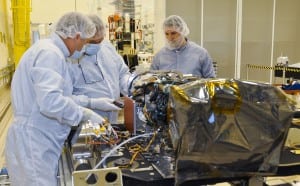Latest News

Lockheed Martin engineers in Denver install the Solar Ultraviolet Imager (SUVI) on the GOES R sun pointing platform. Photo: Lockheed Martin
[Via Satellite 04-21-2014] Lockheed Martin delivered a new solar analysis payload to the National Oceanic and Atmospheric Administration’s (NOAA) Space Weather Prediction Center in Boulder, Colo. The payload will help scientists better measure and forecast space weather, which can be damaging to satellites and ground systems on Earth such as electrical grids.
The Solar Ultraviolet Imager (SUVI) instrument was integrated with NOAA’s first next-generation Geostationary Operational Environmental Satellite, also known as GOES R. The SUVI will issue real-time alerts if it detects a threat that could affect the technological performance of systems in space or on the ground from solar activity such as coronal holes, solar flares and coronal mass ejections (CMEs). SUVI will also better predict geomagnetic storms and power blackout forecasts.
Lockheed Martin is under contract to build the first four next-generation GOES satellites (R, S, T and U). Four of the six instruments for the GOES R satellite have been delivered to the Lockheed Martin facility in Denver, Colo. The launch of the satellite is scheduled for early 2016.
Get the latest Via Satellite news!
Subscribe Now